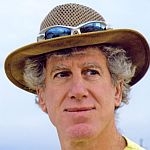 (HOST) At the same time that Champlain was exploring further north, Henry Hudson was sailing through what would become New York City. Commentator Ted Levin has been trying to imagine what it looked like back then.
(HOST) At the same time that Champlain was exploring further north, Henry Hudson was sailing through what would become New York City. Commentator Ted Levin has been trying to imagine what it looked like back then.
(LEVIN) Four hundred years ago this month, September 1609, Henry Hudson was exploring the river that today bears his name, and the island that F. Scott Fitzgerald would later described as "the fresh, green breast of the New World." And what a "breast" it must have been. According to Eric Sanderson, a senior ecologist at the Wildlife Conservation Society, headquartered at the Bronx Zoo, if Manhattan remained as Hudson saw it, the island would have been the crown jewel of our national park system. It had morebiodiversity than Yellowstone, more plant species than Yosemite, and more bird species than the Great Smokies.
Sanderson knows. For the past decade, he has imagined as precisely as possible what Manhattan looked like to Henry Hudson, visualized the nature of an island now subsumed in concrete and macadam and millions of people so detached from the forces of nature that they’d be hard press to point north.
To the local tribe, the Canarsee Lenape, Mannahatta meant "land of many hills," small, thickly forested hills of towering chestnut and white oak that supported flocks of passenger pigeons. Only thirteen miles long and twenty-five square miles in area, Manhattan is shorter than the drive between my Thetford home and nearby Norwich. Mannahatta circa 1609 was peppered with twenty-one ponds and laced with sixty-six miles of streams, a composite of fifty-five ecological communities, including white-sand beaches, fresh and saltwater marshes, and grasslands. And of course hills, including Murray Hill, which I recall from my boyhood as a telephone exchange, not as a prominent geologic feature.
Using a 1783 British military map, Sanderson plotted the original topography of Manhattan and then, based on a knowledge of ecology he imagined what species lived on the island – black bear, beaver, catamount, elk, deer, and wolf, for instance, and more than 250 species of birds. I know from my own work that a timber rattlesnake collected in Manhattan in 1758 was the first New World snake classified by Linnaeus.
I found Sanderson’s website and I entered my childhood address, on West End Avenue between 101st and 102nd streets, not far from Riverside Drive. Based on 3-D modeling software, a map appeared that showed my old neighborhood as a dense deciduous woodland not far from the sandy shores of the Hudson River. Henry Hudson Parkway was built on landfill; in 1609, the Hudson was wider by several hundred yards near the upper West Side.
I typed in City landmarks to see what they might have looked like 400 years ago. The New York Public Library was a forest; Madison Square Garden a marsh; and the World Trade Center an offshore bed of eelgrass.
Unfortunately, the 3-D program wouldn’t lead me across the Harlem River to 161 Street, the wilderness of the South Bronx, where herds of elk might have grazed on the edge of a wetland and Derek Jeter would one day spray base hits like so many birds bolting from cover.